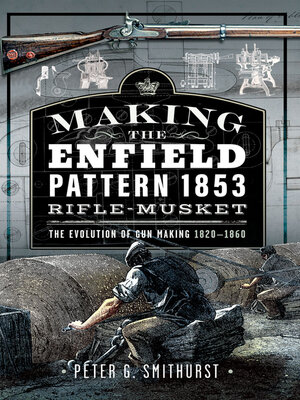Making the Enfield Pattern 1853 Rifle-Musket
ebook ∣ The Evolution of Gun Making, 1820–1860
By Peter G. Smithurst

Sign up to save your library
With an OverDrive account, you can save your favorite libraries for at-a-glance information about availability. Find out more about OverDrive accounts.
Find this title in Libby, the library reading app by OverDrive.



Search for a digital library with this title
Title found at these libraries:
| Library Name | Distance |
|---|---|
| Loading... |
Explores the transition from hand-crafted to mechanized production of military firearms, focusing on the French Model 1777 and Russian Model 1808 muskets.
A variety of factors surround military firearms – they needed to be produced in large numbers to a standardised pattern at an affordable price. This book examines the transition from traditional hand-craft methods to the beginnings of mechanised manufacture using as examples the French Model 1777 and the Russian Model 1808 infantry muskets.
A number of factors led to this choice. The French Model 1777 musket, designed by Honoré Blanc working under General Gribeauval, contained many novel features which became blueprints for the arms of numerous countries and was copied in its entirety by Russia. Another factor is that they are the only firearms whose manufacture is covered in contemporary accounts. A third factor is that they provide contrasts in their methods of manufacture; the French 1777 musket was largely produced by hand-craft methods, whereas in Russia we see the beginnings of extensive mechanisation in the early 19th century.
Another important aspect which appears is ‘interchangeability’ – the ability to exchange identical parts of identical mechanism without ‘special adjustment’. This is a vital factor at the foundation of modern manufacturing and first appears in early 18th century France, was pursued again by Blanc in 1777 and was picked up in Russia.
For the first time, all these ‘technologies’ are examined, explained, compared and contrasted in extensive detail.
A variety of factors surround military firearms – they needed to be produced in large numbers to a standardised pattern at an affordable price. This book examines the transition from traditional hand-craft methods to the beginnings of mechanised manufacture using as examples the French Model 1777 and the Russian Model 1808 infantry muskets.
A number of factors led to this choice. The French Model 1777 musket, designed by Honoré Blanc working under General Gribeauval, contained many novel features which became blueprints for the arms of numerous countries and was copied in its entirety by Russia. Another factor is that they are the only firearms whose manufacture is covered in contemporary accounts. A third factor is that they provide contrasts in their methods of manufacture; the French 1777 musket was largely produced by hand-craft methods, whereas in Russia we see the beginnings of extensive mechanisation in the early 19th century.
Another important aspect which appears is ‘interchangeability’ – the ability to exchange identical parts of identical mechanism without ‘special adjustment’. This is a vital factor at the foundation of modern manufacturing and first appears in early 18th century France, was pursued again by Blanc in 1777 and was picked up in Russia.
For the first time, all these ‘technologies’ are examined, explained, compared and contrasted in extensive detail.







